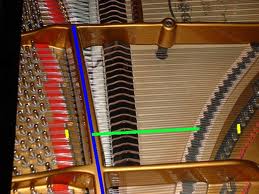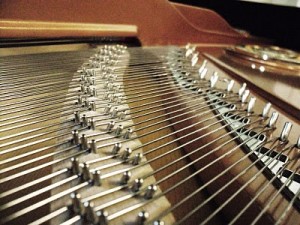“Does my piano tuner have to play so loudly when tuning? Is he deaf? Can he not hear what he’s playing, for crying out loud? Is he going to hurt my piano by playing so hard? Maybe I ought to call someone else who can hear better and tune more softly.”
These are great questions that I’ve never actually been asked before, but I have see the quizzical looks on the customer’s faces at times and have gone ahead and answered those questions for them to put them at ease.
The answers are…
“Yes” the piano keys needs to be played really firmly while tuning.
“No” your tuner is likely not deaf. He can hear what he’s doing, but there is a real purpose to why he is playing so firmly.
And “no” it doesn’t hurt your piano.
Each string of a piano passes over, under, and around several friction points as it makes its way from one end of the piano to the other, from the tuning pin to the hitch pin. This creates a situation where you now have the “speaking length” of the string, and the “non-speaking lengths” of the string (see pictures below).
The “speaking length” is the longer vibrating part of the string that makes the sound when you play. If you tightly stretched a rubber band between two fingers, then plucked it…the entire rubber band would be vibrating and sounding (except the parts touching your fingers). The vibrating, sounding part of the rubber band is the “speaking length”. The part touching your fingers does not vibrate and sound and therefore is “non-speaking”. Notice the green line in the picture shows the “speaking length” of that string.
The “non-speaking lengths” are at each end of the string and are the little sections between friction points that are not usually part of the sound when played. In the picture above, it is all the parts of the string to the left and right of the green line. The part of the strings that go from the tuning pin to the pressure bar/capo or “v” bar/ or agraffes, as well as at the end (or bottom of the piano) between the stagger pins on the bridge, and from the bridge pin to the hitch pin. All these sections are considered “non-speaking lengths” of the string since they aren’t the part of the string responsible for making the music.
The picture you see here is a close up of the hitch pins (far right) and the bridge pins (or stagger pins at left). The section of string to the left of the bridge is the “speaking length” and is the main part of the string. So, again, all of the string from the time it enters the stagger pins at the left, and goes around the hitch pin at the right and comes back through the stagger pins is all considered the “non-speaking” length of the string.
So, what happens when a note is played loudly during tuning?
What happens during tuning is that the string is being stretched and pulled through all of the friction points. Because of friction, it may pull all the way through some of the friction points, and not so much on others, leaving the tension at different amounts along the length of the string. A practical example of that would be when you tie your shoes. If your laces are really loose to begin with, as you pull on the laces, it will sometimes tighten some sections tighter than others. You have to get in there with your hands, usually, to kind of pull each section to about the same tightness before going ahead and tying them. The tuner has to do that also in the piano. He does that by playing a firm blow. All the energy from that firm blow rushes up and down the string, through the friction points, and allows all the sections of the string to equalize their tension, thus making the tuning more stable.
If your tuner didn’t do this, the tuning would be very unstable. It might sound good for a little while, especially if played very softly, however, soon after the tuner leaves and you began playing a loud piece of music, the strings would equalize their tension, causing everything to go wildly out of tune. So, we are equalizing the tension along the full length of the string when we play loudly during tuning.
Does it hurt the piano when the tuner plays loudly?
While it may make you feel uncomfortable during the tuning process, under normal circumstances, the tuner’s loud playing will definitely not hurt your piano. The piano is built to withstand quite a firm blow for pieces of music marked ffff. However, it is not beyond the scope of possible for something to break, especially if the piano is extremely old and the parts are pretty dry and glue joints are brittle. Even at that, it is extremely rare for the tuning process to ever damage the piano by playing firm tuning blow.
So, next time you call your tuner, get your earplugs if you need, but be rest assured that your tuner is doing what is necessary to ensure you have a piano that stays in tune as long as possible.
Until next time…..make a joyful noise!

